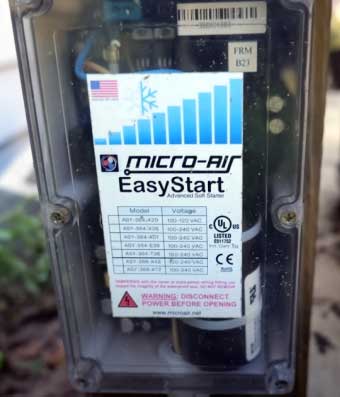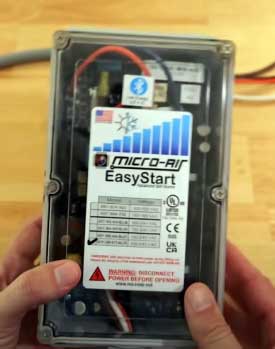If you’re considering an upgrade to your air conditioning setup, you might have come across the Micro-Air EasyStart Flex. This product is often promoted as a solution to reduce compressor strain and smoothen the start-up process, but is it really worth the investment?
Let me share some of my honest thoughts, based on both research and personal insight. Spoiler alert—you might want to think twice before making this purchase.
My Experience Using The Micro-Air EasyStart Flex
I decided to give the Micro-Air EasyStart Flex a try because of the promise of smoother AC start-ups and reduced power consumption. The initial installation was straightforward, and I appreciated the compact design and Bluetooth connectivity.

Setting it up was easy enough, and I was excited to monitor the performance through the app.
However, my excitement quickly turned into disappointment.
After only two weeks of use, the device suddenly stopped working.
I noticed a brown liquid inside the unit, which I later learned was probably capacitor electrolytes.
This was frustrating, especially considering the $400 price tag.
I reached out to customer support, but the refund process was painfully slow, taking over two weeks to get my money back.
The inconsistency in performance was a major letdown. While it worked, the EasyStart Flex did help with reducing the startup noise and power surge, but the unreliability overshadowed these benefits.
Given the high cost and the hassle of dealing with returns, I can’t confidently recommend this product. I ended up switching to a more reliable alternative, and I’ve had no issues since.
Pros of The Micro-Air EasyStart Flex
I’ll give credit where it’s due—the Micro-Air EasyStart Flex does come with a few notable advantages, which initially made it an attractive option to me.
- Energy Efficiency
The promise of cutting down on energy consumption was a big draw. The EasyStart Flex claims to reduce the power spike by up to 75% when starting the air conditioner, which means the compressor isn’t forced to draw as much energy to get running.
Theoretically, this should lead to reduced energy bills and potentially prolong the life of your air conditioning unit. In an era where we’re all trying to be more energy-conscious, that sounded like a great feature.
- Compatibility with Generators
Another plus is that the EasyStart Flex can help run your AC unit off a generator. If you’re an RV enthusiast or you rely on backup power, this feature could be invaluable. It means you don’t have to worry about large power surges overwhelming your generator or tripping the circuit breaker. A smooth start every time? Sounds like a dream.
- Bluetooth Connectivity
Technology is supposed to make our lives easier, and the Bluetooth connectivity on the EasyStart Flex seemed like a step in that direction. Having the ability to check on and control the AC unit directly from a smartphone was a feature I really liked. Being able to track performance, make adjustments, and troubleshoot without having to open up the device adds a modern convenience that I think we all could appreciate.
- Compact and Easy Installation
The EasyStart Flex is relatively compact, making it easy to install in tight areas. It’s compatible with a wide range of AC units, which can simplify things if you’re installing it yourself. Plus, it’s advertised as user-friendly—just hook it up, and the system takes care of the rest. However, “advertised” is the key word here, because reality doesn’t always match expectations.
Cons of The Micro-Air EasyStart Flex
Now that I’ve highlighted some of the positives, let’s talk about what ultimately tipped the scales for me and made me regret my decision to give the EasyStart Flex a try.
- Questionable Reliability

From my experience and a lot of the reviews I’ve read, there seems to be a significant reliability issue.
I’ve heard of users experiencing problems where the EasyStart Flex stopped working entirely within weeks of installation.
Some people reported a brown liquid leaking inside—presumably electrolytes from a blown capacitor.
I had hoped these were isolated incidents, but after reading more about it and seeing similar issues pop up repeatedly, it became clear this was not just bad luck.
Personally, the idea of my AC system breaking down in the middle of a hot summer due to a failed device doesn’t inspire much confidence.
- High Cost Without the Expected Returns
The EasyStart Flex costs around $400, which isn’t cheap for an accessory. I initially justified the price by expecting lower energy bills and less strain on my AC unit.
However, given that reliability issues seem to be prevalent, the potential repair costs or replacement expenses undermine any energy savings that I could achieve. Spending $400 on a device that only worked for 10 days? It’s not a gamble I’d like to take again.
- Mixed Results with Different AC Units
I’ve also seen people mention that their EasyStart Flex didn’t work properly with their AC unit—even though the unit was supposed to be compatible. One common issue reported is that the LED green light, indicating proper functioning, never turned on despite the device receiving power.
This kind of inconsistency makes me uneasy, especially considering the hassle of trying to get refunds or replacements. It just didn’t seem worth the potential headache.
- Refund and Warranty Issues
Another downside I noticed is the difficulty people had with the refund process. It’s not uncommon for customers to have to wait weeks to get their money back, and that’s only if they’re persistent enough.
Dealing with product returns is always frustrating, and with a high-cost item like this, you’d expect better service. The return experience seems to be another pain point for many buyers, and it’s something that I personally found unacceptable.
Maintenance Tips For Micro-Air EasyStart Flex
If, despite all the drawbacks, you still decide to give the EasyStart Flex a go, here are a few tips that might help you extend its lifespan and get the most out of it.
- Install It Correctly
This might sound obvious, but proper installation is key to getting the device to work as expected. If you’re not comfortable working with electrical components, it’s worth getting a professional HVAC technician to install it for you.
Make sure all connections are solid, and follow the manual carefully.

- Check for Firmware Updates: The Bluetooth feature allows for firmware updates, which could help address some of the issues that have been reported. Regularly check for updates, as they may contain fixes or improvements that could make a difference in the device’s performance.
- Monitor Performance: Using the Bluetooth app, keep an eye on the EasyStart’s performance, especially in the initial weeks. If you notice anything unusual—like error messages, excessive heat, or no LED indicators—it might be worth reaching out to customer support immediately. Addressing issues early might prevent more serious damage.
Comparing EasyStart Flex With Competitors
To give you a better idea of whether the EasyStart Flex is worth your investment, let’s compare it to a couple of similar products on the market.
- SoftStartRV
SoftStartRV is another popular soft starter, particularly for RV owners. Compared to the EasyStart Flex, SoftStartRV has a solid track record with more consistent reviews and fewer reliability issues.
While it doesn’t have the Bluetooth connectivity that the EasyStart Flex boasts, it’s generally more straightforward and dependable. If I had to choose between these two, I’d go with reliability over fancy features any day—and SoftStartRV seems to be the better bet.
- Hyper Engineering SureStart
The Hyper Engineering SureStart is designed for residential and commercial HVAC units, and it’s a bit more industrial in nature. It doesn’t offer the compact size of the EasyStart Flex, but it’s known for durability and reliability.
The SureStart also lacks Bluetooth features, but again, it’s reliability and longevity that set it apart from the EasyStart Flex. If your goal is to make sure your air conditioner works when you need it, SureStart seems to deliver on that promise more consistently.
- Dometic SmartStart
Dometic SmartStart is another competitor to consider, particularly if you’re already familiar with Dometic’s line of RV products. The Dometic SmartStart focuses on reducing the start-up current, much like the EasyStart Flex, and it does a decent job for RV applications.
Reviews indicate fewer major issues compared to the EasyStart Flex, although it doesn’t have wireless monitoring capabilities. If Bluetooth isn’t a deal-breaker for you, the Dometic SmartStart could be a worthwhile option.
Frequently Asked Questions (FAQ)
Yes, it can help save money by reducing the power surge required during start-up, which may lead to lower energy bills. However, considering the reliability issues and the high initial cost, these savings may not justify the price for everyone.
The Micro-Air Easy Start reduces the initial power draw needed to start your air conditioning compressor. It helps to smoothen out the start-up process, which can be beneficial when running the unit on a generator or in situations where power availability is limited.
It depends on your priorities. If you prefer reliability and consistent performance, a product like SoftStartRV may be a better option compared to the EasyStart Flex, which has mixed reviews and reliability concerns. The EasyStart Flex does offer Bluetooth connectivity, but that comes at the cost of dependability.
The EasyStart 364 and 368 are different models in the EasyStart series. The 364 is designed for smaller units, typically found in RVs, while the 368 can handle slightly larger and more powerful units. Depending on your AC unit’s power requirements, you would choose one or the other.
Final Thoughts
While the Micro-Air EasyStart Flex has some promising features, like energy efficiency, Bluetooth connectivity, and compatibility with generators, its reliability issues and high cost make it a risky investment.
If you’re like me and prefer a dependable solution without the fear of sudden breakdowns, you might want to explore other alternatives before committing to the EasyStart Flex.
